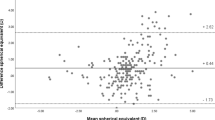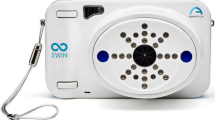Abstract
Background. High ametropia is known as a risk factor in developing amblyopia. The aim of the study was to evaluate the efficiency of a commercially available infrared videorefractometer (PowerRefractor) in examining children, and to evaluate its effectiveness in detecting amblyogenic factors of the refraction. The influence of cycloplegia was of interest.
Methods. A total of 255 eyes (–28.25 D to +7.88 D spherical equivalent) of 128 patients (1–81 years) were examined by cycloplegic retinoscopy. All of them were measured with the PowerRefractor under cycloplegia. Fifty-four of these patients (108 eyes) were additionally measured without cycloplegia. The technique of the device is based on the eccentric photorefraction method. Both eyes can be measured simultaneously from a distance of 1 m. A video-analysis of each eye is computed in three meridians. The subject can be observed in real time on a screen, and the refraction is immediately available.
Results. Measurement of refraction was possible at all ages. More effort was required with young children who could not cooperate well with the procedure of conventional table-top autorefractometers. The mean sensitivity in detection of any amblyogenic ametropia was 80% with and without cycloplegia. The specificity was 61% with cycloplegia and 84% without. The rate of false-negative results in the detection of anisometropia, hyperopia and astigmatism ranged from 10% to 24%. In particular, high astigmatism and hyperopia remained undiscovered.
Conclusions. The reliability of the photorefractor which was the subject of the evaluation in detecting amblyogenic ametropia was comparable to that of other devices described previously in the literature. The method is suitable for use in children, but anisometropia, high astigmatic and hyperopic ametropia remained undiscovered in several cases. Commercial interest: none.
Similar content being viewed by others
Author information
Authors and Affiliations
Additional information
Electronic Publication
Rights and permissions
About this article
Cite this article
Schimitzek, T., Haase, W. Efficiency of a video-autorefractometer used as a screening device for amblyogenic factors. Graefe’s Arch Clin Exp Ophthalmol 240, 710–716 (2002). https://doi.org/10.1007/s00417-002-0524-5
Received:
Revised:
Accepted:
Published:
Issue Date:
DOI: https://doi.org/10.1007/s00417-002-0524-5




